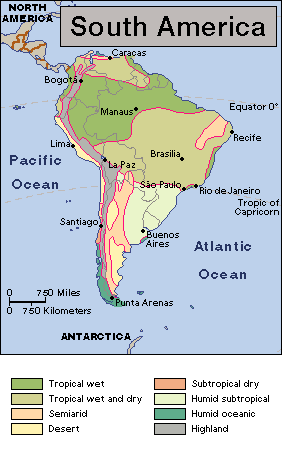 |
Content Spotlight
|
 |
|
Subscribe to the Full World Book Online Reference Center
|
|
South American climate
South America has a wide range of climates. Most of the continent receives ample rain. However, the Atacama Desert in northern Chile is one of the driest places on earth. The map and legend show what the climate is like throughout the continent.

Climate
South America has a wide variety of climates. They range from the dry desert conditions of northern Chile to the heavy rains along the windswept southwestern coast of the continent. Steamy heat characterizes the tropical rain forest of the Amazon basin, while icy cold air surrounds the lofty, snow-capped Andean peaks. In general, however, most of the continent has warm weather the year around. Only in the high Andes is it always cold.
The hottest weather in South America occurs in Argentina's Gran Chaco, where the temperature reaches 110 degrees F. (43 degrees C). Temperatures in the Amazon region generally range from 70 degrees to 90 degrees F. (21 degrees to 32 degrees C) and rarely reach 100 degrees F. (38 degrees C). South of the equator, summer lasts from late December to late March, and winter runs from late June to late September. In the far south of Argentina, the temperature generally ranges from 32 degrees F. (0 degrees C) in July to 60 degrees F. (16 degrees C) in January, but it has dropped to as low as -27 degrees F. (-33 degrees C).
Rainfall
Most of South America receives ample rain. Rainfall averages more than 80 inches (200 centimeters) a year in four areas: (1) coastal French Guiana, Guyana, and Suriname; (2) the Amazon River Basin; (3) southwestern Chile; and (4) the coasts of Colombia and northern Ecuador. Quibdo, Colombia, the rainiest place in South America, receives more than 350 inches (890 centimeters) of rain a year. Even the wettest regions of the continent generally have a dry season, however, when there is plenty of sunshine between downpours.
In southwestern Chile, humid westerly winds blow in from the Pacific and drop most of their moisture as rain before crossing the Andes. As a result, the area east of the Andes is very dry. For example, the plateaus of Patagonia, in southeastern Argentina, receive only about 10 inches (25 centimeters) of rain a year.
Coastal Peru and northern Chile are among the driest places on earth. Arica, the northern port city of Chile, receives an average of only 3/100 inch (0.76 millimeter) of rain a year. The dry conditions in this part of the continent result from the cold Peru Current, which flows northward just off the coast. This current cools the air. Because such cool air cannot hold much moisture, little rain falls in the region.
At irregular periods, usually every two to seven years, the northward Peru Current weakens and stronger warm waters flow southward along the coast. This event is called El Nino (Spanish for the child). It usually occurs around Christmas, and its name refers to the Christ child. El Nino creates changes in the atmosphere that lead to torrential downpours in the usually dry region. The changes also disrupt marine life, hurting the local fishing industry.
return to top
|
